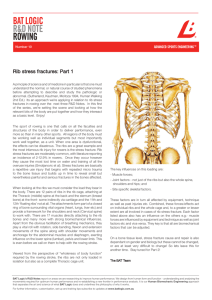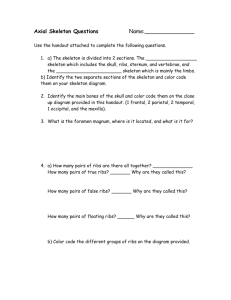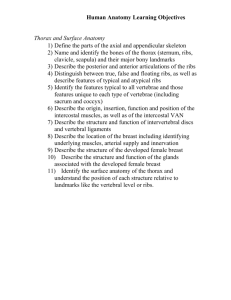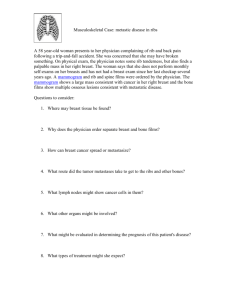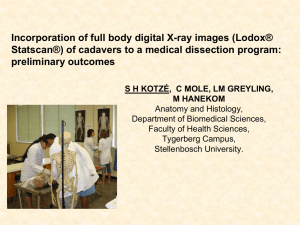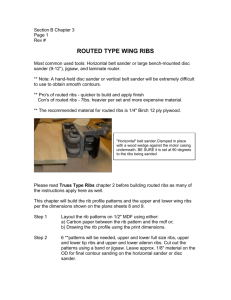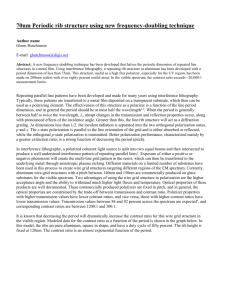Rib cage diagnosis - New York Institute of Technology
advertisement
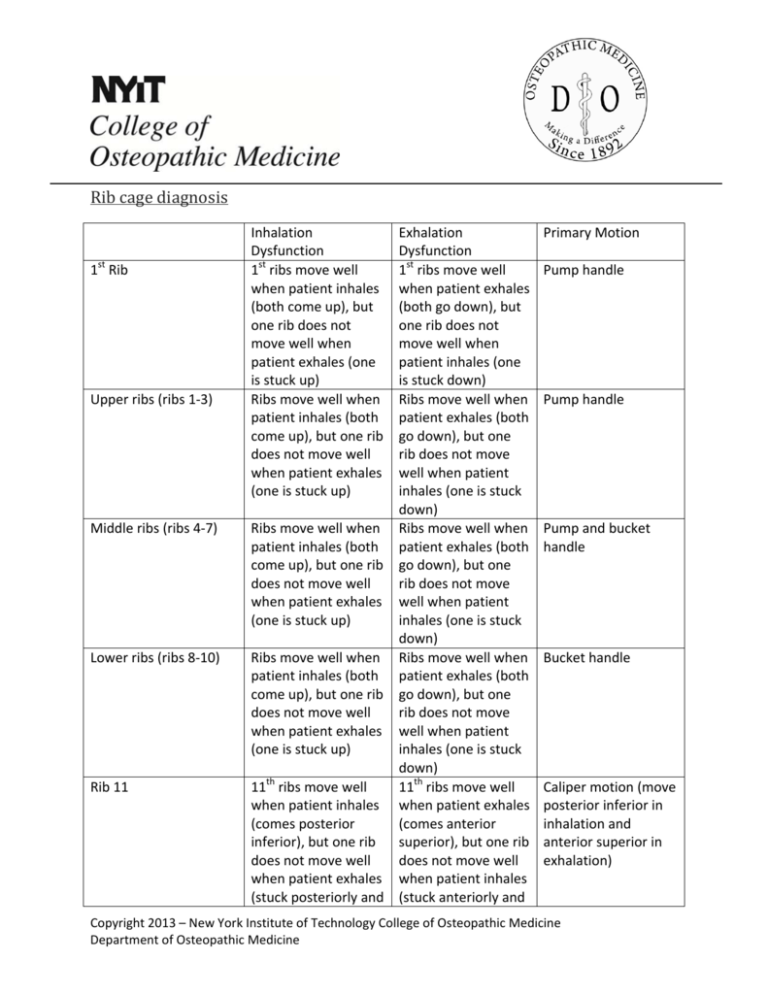
Ribcagediagnosis 1st Rib Upper ribs (ribs 1‐3) Inhalation Dysfunction 1st ribs move well when patient inhales (both come up), but one rib does not move well when patient exhales (one is stuck up) Ribs move well when patient inhales (both come up), but one rib does not move well when patient exhales (one is stuck up) Middle ribs (ribs 4‐7) Ribs move well when patient inhales (both come up), but one rib does not move well when patient exhales (one is stuck up) Lower ribs (ribs 8‐10) Ribs move well when patient inhales (both come up), but one rib does not move well when patient exhales (one is stuck up) Rib 11 11th ribs move well when patient inhales (comes posterior inferior), but one rib does not move well when patient exhales (stuck posteriorly and Exhalation Dysfunction 1st ribs move well when patient exhales (both go down), but one rib does not move well when patient inhales (one is stuck down) Ribs move well when patient exhales (both go down), but one rib does not move well when patient inhales (one is stuck down) Ribs move well when patient exhales (both go down), but one rib does not move well when patient inhales (one is stuck down) Ribs move well when patient exhales (both go down), but one rib does not move well when patient inhales (one is stuck down) 11th ribs move well when patient exhales (comes anterior superior), but one rib does not move well when patient inhales (stuck anteriorly and Primary Motion Pump handle Pump handle Pump and bucket handle Bucket handle Caliper motion (move posterior inferior in inhalation and anterior superior in exhalation) Copyright 2013 – New York Institute of Technology College of Osteopathic Medicine Department of Osteopathic Medicine Rib 12 inferio orly) th 12 ribs move we ell when patient inhaales (come es posterior inferio or), but one rib does n not move we ell when patient exhaales (stuckk posterior inferio orly) superriorly) 12th rribs move weell whenn patient exh hales (comees anterior superrior), but one rib does not move w well hales whenn patient inh (stuckk anteriorly and superriorly) Caliper motion (m move posteerior inferiorr in inhalation and anterrior superiorr in exhalation) Figure 1 ‐ 1sst rib diagnosis hand placementt Figure 2 ‐ Upper rib diagnosis Middle rib diagno osis Figure 3 ‐ M Figure 4 ‐ Midddle rib diagnosiss alternate hand d positioning Copyrightt 2013 – New York Institute e of Technolo ogy College off Osteopathicc Medicine Departme ent of Osteop pathic Medicin ne Figure 5 ‐ Lo ower rib diagnosis Figure 6 ‐ Riibs 11 and 12 diagnosis Brief desscription: Diaagnosis of thee ribs should aassess the firsst ribs, upperr (1‐3 ribs), m middle (4‐7 rib bs), lower (8‐1 10 ribs), ribs 1 11 and 12. Motion of the ffirst ribs and uupper ribs aree primarily pu ump handle, middle is a mix of pum mp and buckett handle, while the lower rribs are mostly bucket han ndle. Ribs 11 aand 12 are unique in that they have caliper motion. IIt is also impoortant to deteermine the keey rib of a on for treatm ment. In inhalaation dysfunctions, the keyy rib is the bo ottom rib. In eexhalation dysfunctio dysfunctio ons, the key rrib is the top rib. Look (ob bservation): Observe the patient’s breaathing and lo ok for any scars or marks. Copyrightt 2013 – New York Institute e of Technolo ogy College off Osteopathicc Medicine Departme ent of Osteop pathic Medicin ne Firstribdiagnosis Physician position: Sit at the head of the table Patient position: Supine Hand positioning: To assess the first rib, contact it below the clavicle where the first rib joins the sternum, above the clavicle on the anterior superior aspect of the rib and on the posterior aspect of the first rib in the trapezius. Technique: 1. Place your hands so that you have a 3‐point contact on the first rib bilaterally (thumbs on the posterior aspect of the rib in the trapezius, index fingers on the anterior superior aspect just above the clavicles and the middle fingers at the attachment of the first rib on the sternum). 2. Add a compressive force on the ribs and feel for which is harder to spring on. This rib is stuck up in inhalation. 3. You can also test motion with respiration by having the patient inhale and exhale while you have your 3‐point contact. Feel for the ribs to move up in inhalation and down in exhalation. 4. To name the dysfunction, determine the freedom. (Ex. Both move well in inhalation, but on exhalation the right first rib stays stuck up. This would be a right first rib inhalation dysfunction.) Move (motion testing): Active motion testing: 1. Have the patient inhale and exhale while you maintain a 3‐point contact on the first rib. Passive motion testing: 1. Spring on the rib by compressing down. The side with more resistance to this springing is stuck up in inhalation. Other notes: The first rib is small and like a collar. It is often very tender to palpation. Copyright 2013 – New York Institute of Technology College of Osteopathic Medicine Department of Osteopathic Medicine Rib1‐10diagnosis Physician position: Stand to either side of the patient Patient position: Supine Hand positioning: To assess pump handle motion, place your hands parallel and just lateral to the sternum. To assess bucket handle motion of the upper (1‐3) ribs, place your hands horizontal under the clavicle. To assess bucket handle motion of the middle (4‐7) and lower (8‐10) ribs, place your hands over the costal margin and lateral aspects of the rib cage. Technique: 1. Place your hands so that they are parallel and just lateral to the sternum in the region of ribs 1‐3. 2. Have the patient inhale and exhale while feeling for a pump handle motion. 3. Now move your hands so that they are horizontal and just under the clavicles to assess for bucket handle motion. 4. Again, have the patient inhale and exhale while this time feeling for bucket handle motion. 5. Place your hands so that they are parallel and just lateral to the sternum in the region of ribs 4‐7. 6. Have the patient inhale and exhale while feeling for a pump handle motion. 7. Now move your hands so that they are on the lateral aspects of the rib cage. (Hands will be partly in the mid‐axillary line.) 8. Again, have the patient inhale and exhale while this time feeling for bucket handle motion. 9. Place your hands so that they are parallel and just lateral to midline in the region of ribs 8‐10. 10. Have the patient inhale and exhale while feeling for a pump handle motion. 11. Now move your hands so that they are on the costal margin of the rib cage. (Hands will be over the costal margin and fingers out to the lateral aspects of the rib cage.) 12. Again, have the patient inhale and exhale while this time feeling for bucket handle motion. 13. To diagnosis the dysfunction, name for the freedom of motion. (Ex. Ribs 4‐7 are symmetrical on exhalation, but on inhalation the right ribs 4‐7 are stuck down. This would be a right ribs 4‐7 exhalation dysfunction.) Move (motion testing): Active motion testing: 1. Have the patient inhale and exhale while you check both pump handle and bucket handle motion. 2. Assess this in all 3 regions (upper, middle and lower ribs). Copyright 2013 – New York Institute of Technology College of Osteopathic Medicine Department of Osteopathic Medicine Passive motion testing: 1. Compress the rib cage and try to move it from left to right. Feel for any general restrictions of movement. Other notes: The motion of the ribs varies between pump and bucket handle motion as you move from the top to the bottom of the rib cage. The upper (1‐3) ribs are primarily pump handle motion, middle (4‐ 7) ribs are both and lower (8‐10) ribs are primarily bucket handle. The key rib of the dysfunction is important for treatment and is determine as follows: for inhalation dysfunctions it is the bottom rib, for exhalation dysfunctions it is the top rib (mnemonic is “BITE” = bottom, inhalation; top, exhalation). Copyright 2013 – New York Institute of Technology College of Osteopathic Medicine Department of Osteopathic Medicine 11thand12thribdiagnosis: Physician position: Stand to either side of the patient Patient position: Prone Hand positioning: Place your hands so that your index finger and thumb are over the 11th ribs bilaterally and then 12th ribs bilaterally (each rib is diagnosed separately). Technique: 1. Place your hands over the 11th ribs bilaterally and try to contact as much of the rib as possible. 2. Have the patient inhale and exhale. Feel for a posterior‐inferior motion on inhalation and anterior‐superior motion on exhalation. 3. Now place you hands over the 12th ribs bilaterally. Again, try to contact the entire rib with your thumb and index finger. 4. Have the patient inhale and exhale. Feel for a posterior‐inferior motion on inhalation and anterior‐superior motion on exhalation. 5. To diagnosis the dysfunction, name for the freedom of motion. (Ex. Rib 11 moves posterior‐inferior bilaterally, but the right rib 11 does not move anterior‐superior. This is a right rib 11 inhalation dysfunction.) Move (motion testing): Active motion testing: 1. While maintaining your contact on ribs 11 or 12, ask the patient to inhale and exhale. Passive motion testing: 1. Check the motion of ribs 11 and 12 while the patient relaxes and breathes normally. Other notes: Ribs 11 and 12 are floating ribs and do not attach to the anterior portion of the rib cage. Ribs 11 and 12 have caliper motion, they move posterior‐inferior with inhalation and anterior‐superior with exhalation. These ribs can be found by walking your hands up from the iliac crests until you hit bone and then walking your fingers anteriorly to make sure they are not attached to the ribcage anteriorly. Alternatively, you may walk your fingers down the mid‐axillary line until you get to the end of the ribcage and then walk your fingers posteriorly to find the ribs. Ribs 11 and 12 are often tender to palpation. Copyright 2013 – New York Institute of Technology College of Osteopathic Medicine Department of Osteopathic Medicine
